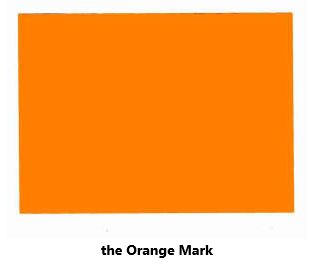Cheers to That
2006 was a time for celebration as trade mark registration of the below colour mark was finally granted in the EU to French organisation M.H.C.S. (owners of the famous champagne brand Veuve Clicquot) after the EU Second Board of Appeal annulled the trade mark examiner’s decision of 19 December 2003. They concluded that it had been demonstrated that a distinctive character had been acquired through use in respect of Champagne wines.

To this point, the battle for trade mark registration had been arduous and it was not over yet…
25 February 2015 - Applications commenced for invalidity of the Orange Mark commenced although this initial application was dismissed on the ground, inter alia, that the Orange Mark had acquired distinctive character through use in the relevant territory.
3 November 2015 - Not satisfied with this decision, a second application for invalidity was commenced.
2 November 2018 - the Cancellation Division handed down its view, amongst other things, that a distinctive character acquired through use of the Orange Mark had been established on the date on which the application for registration was filed in the territory of 15 EU Member States, namely Austria, Belgium, Denmark, Finland, France, Germany, Greece, Ireland, Italy, Luxembourg, the Netherlands, Portugal, Spain, Sweden and the United Kingdom. The reason for the bold text will become apparent.6 December 2018 – the above decision was appealed. The Board of Appeal stated that it was necessary to annul the Cancellation Division’s decision of 12 November 2018 and remit the case to it for reconsideration.
11 May 2020 and 5 November 2021 - Further actions and appeals ensued on these dates. The issues boiled down to whether or not a significant proportion of the relevant public was (at the time of the application for registration of the Orange Mark, being 12 February 1998) accustomed to the relevant shade of orange and that, therefore, there was no doubt that it had become distinctive through use made of it at the time that the Orange Mark was filed.
But Wait, There’s More
This was not, however, the last of the dramas. We turn to Portugal and Greece. To achieve registration of The Orange Mark in the EU it was necessary for the applicant to prove that a distinctive character of The Orange Mark had been acquired through use, relevantly in all 15 EU Member States (including Portugal and Greece).
To Australian IP timeline standards, the below may seem tough.
(1) Portugal –The Board of Appeal had found that distinctive character had been acquired on the basis of advertising examples, a multilingual international brochure and the long-standing marketing of Veuve Clicquot Champagne wines, the first shipment of which dated back to 1864.
However, neither sales figures nor advertising materials were sufficient to establish acquired distinctive character. In addition, the orange-coloured label was not used prior to 1877 and that the consistent use of the same shade of orange cannot be presumed, which was apparent from an image of a bottle from 1964 showing a golden label.
(2) Greece - The Board of Appeal had relied on a first shipment in 1845, prior to an alleged label change. Also relied upon was an acknowledgement by King Constantine of Greece. However, the King apparently could not be regarded as representing the public at large.
In addition, the annual promotion budget of approximately EUR 12 000 was considered very limited.
Had sufficient evidence been adduced indicating acquisition of a distinctive character in Portugal and Greece?
No. The Applicant’s failure to produce sufficient evidence that the Orange Mark had acquired a distinctive character through use in Portugal or Greece was fatal. The Court exercised its power to alter decisions to declare the Orange Mark invalid.
Not a single Veuve Clicquot champagne cork was popped.
Key Takeaway
If acquired distinctiveness can only be proven in a limited number of Member States, the better way may be to obtain trade mark protection either at a national level or by filing an International Registration with individual designations in key territories rather than adopting a blanket EU filing approach.
Our specialist trade mark team can assist with the protection of your valuable branding assets – feel free to contact Louise Blair or the IP team.
This publication has been prepared for general guidance on matters of interest only and does not constitute professional legal advice. You should not act upon the information contained in this publication without obtaining specific professional legal advice. No representation or warranty (express or implied) is given as to the accuracy or completeness of the information contained in this publication and to the extent permitted by law, Cowell Clarke does not accept or assume any liability, responsibility or duty of care for any consequences of you or anyone else acting or refraining to act in relation on the information contained in this publication or for any decision based on it.
